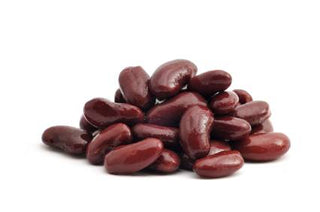(Phaseolis vulgaris)
Kidney beans are legumes which are plants with seed pods that split into two halves. Some of the more common legumes are beans, lentils, peanuts, peas and soybeans. The legume family also includes alfalfa, clover and even the beautiful flowering plant wisteria.
Like all legumes, kidney beans benefit from bacteria (rhizobia) that live in nodules along their roots. These bacteria draw nitrogen from the soil and affix it into a form that the plant uses as a nutrient. The nitrogen fixation ability of legumes allows these plants to be used in crop rotation to replenish the soil depleted of nitrogen. It also increases the protein content of legumes in comparison to non-legume vegetables.
Kidney beans, otherwise known as the chili bean or red bean, are named for their resemblance in shape and color to a kidney. They are firm, medium in size with a dark red skin and a cream colored flesh. Kidney beans are also available in white and are called Cannellini beans.
Nutrition Facts
Kidney beans are one of the most nutritious foods you can eat. They are packed with essential vitamins & minerals and are an excellent source of high-quality protein and dietary fiber.
A cup of cooked kidney beans has 225 calories; the majority coming from carbohydrates. Of these carbs, one-third is from fiber with a serving providing 13 grams of dietary fiber or 52% of daily values.
Like other legumes, kidney beans are an excellent source of protein (about a quarter), with a serving providing 15 grams. Unlike animal proteins, the protein found in kidney beans is low in calories and virtually fat free. Unlike some plant proteins, kidney beans provide the full-range of amino acids, making them a complete protein source.
In their natural state, this legume contains virtually no sodium. But, a cup of canned kidney beans is loaded with sodium (typically well over 600 mg per serving). Rinsing the beans in a strainer will remove most of the sodium.
Kidney beans are good source of the B-vitamins. A serving provides 58% of daily recommended intake for folate and 19% for thiamin. They are also a good source of vitamin K, providing 19% of daily values in just one cup.
This bean also provides an excellent source of magnesium and potassium, providing 20% of daily values. Both minerals are very important for blood pressure management. However eating canned beans without rinsing them first voids this nutritional benefit.
Kidney beans are an excellent source of several other minerals including phosphorus, iron, copper and manganese. Kidney beans provide 42% of daily values for manganese and 29% for iron. This can help increase your energy by replenishing the iron levels in your body.
Health Benefits
Due to their high fiber content, kidney beans can help lower your cholesterol. The fiber in kidney beans is rich in both soluble and insoluble fiber. Due to their high fiber content, consumption of legumes is associated with a significant reduction in heart disease risk.
The fiber in these beans also prevents blood sugar levels from rising too rapidly after a meal. Kidney beans provide steady, slow-burning energy which is especially important for people with diabetes.
The high folate content in kidney beans can help lower your risk of developing heart disease. This B-vitamin along with B-6 and B-12 play a role in lowering homocysteine. Homocysteine is a byproduct of the conversion of the amino acid methionine to cysteine. High levels of homocysteine circulating in the blood damage coronary arteries making it easier for blood clotting cells to clump together and form a clot, which may lead to a heart attack. The combination of these B-vitamins has show to lower homocysteine levels.
Selection & Storage
Whether you purchase dried or canned, kidney beans can easily be purchased year-round.
Like other beans, kidney beans are found in grocery stores in the dry foods or the canned foods section. From a convenience standpoint, purchasing canned beans is much simpler. And, the nutritional value differs little between canned beans and those you cook yourself. However, when purchasing canned beans, pay attention to the label and look for the sodium content. If you can’t find a low-sodium version, be sure to rinse the beans in a colander before using. Some good brands to try are Eden Foods and S&W.
Once opened, always store canned kidney beans in the refrigerator in an air tight container. They will stay fresh for three days when stored in this manner.
Recipes
Traditionally, kidney beans have been used for chili, soups, stews and salads. They are known for their robust flavor, retaining shape and the ability to absorb other flavors when cooked. Cannellini Beans are most often used in traditional Italian dishes.
Kidney beans are a great addition to meals. They can be added to your favorite salad or pasta dish. Kidney beans, with their high protein content, are a great replacement for meat. Go Meatless Mondays by combining the bean with a whole grain like brown rice for a low -calorie and non-saturated fat meal.
A quick and easy dish is to combine red and white Kidney beans with black beans to make a colorful three bean salad. Mix with tomatoes and scallions and dress with olive oil, lemon juice, salt and black pepper.
You can also make a quick dip with kidney beans, cottage cheese along with your favorite spices. This dip is paired perfectly with veggies like carrots and cucumbers.
Soups and chili are ideal foods to make in the winter to provide warmth and essential nutrients for your body. This delicious Minestrone Soup recipe calls for both red and white kidney beans. Or try a new twist on your classic chili with this three bean chili recipe.
Fun Fact
Kidney beans actually heal and help maintain kidney function and look exactly like human kidneys.

